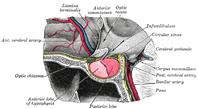This case report possibly raises as many (or more) questions as it claims maybe to answer!
Abstract #825
CHRONIC MARIJUANA USE AS A POTENTIAL CAUSE OF HYPOPITUITARISM
Richard Pinsker, MD, Hineshkumar Upadhyay, MD, Narindar Kukar, MD, Prakashkumar Patel, MD, David Lee, BS, Kelly Cervellione, MPhil Jamaica Hospital Medical Center
Objective
Hypopituitarism is most often caused by a mass lesion and less commonly by inflammatory, infiltrative, or vascular disease. Tetrahydrocannabinol (THC), the psychoactive ingredient of marijuana, has ability to alter various neural transmitters in the hypothalamus or neural transmitters in the CNS which affect the hypothalamus. We report a case of hypopituitarism seemingly secondary to chronic marijuana use.
Case Presentation
A 37-year-old male presented to the Emergency Department with symptoms of dyspnea on exertion, increasing fatigue, and loss of libido. The patient reported daily use of marijuana for 15 years. There was no history of radiation exposure or head trauma. On physical exam, significant findings of bibasilar rales, gynecomastia, and bilateral atrophied testis were noted. Considering the possibility of hemochromatosis, iron studies and echocardiography were completed, which were normal. Hormonal evaluation revealed low LH (0.2 mIU/mL), FSH (1.8 mIU/mL) and testosterone (22 ng/dL) along with high prolactin (53.3 ng/mL). Further endocrine chemistry revealed ACTH of 6 pg/mL, and cortisol at 0 and 60 minutes following administration of cosyntropin of 6.4 ug/dL, and 9.3 ug/dL respectively. Additional lab studies revealed low total T3 (30 ng/dL), high T3 resin reuptake (49%), low total T4 (3.94 ug/dL), normal free T4 (0.97 ng/dL) and low TSH (0.22 uIU/ml). In addition, growth hormone was within normal limits (5.0 ng/mL) and IGF-1 was low (75 ng/mL; Z-score of -1.3). MRI of head showed a protuberant pituitary gland that was slightly larger than expected size, but there was no identified mass lesion. The patient was started on cortisone 25 mg in the morning and 12.5 mg at bedtime and levothyroxine 25 mcg daily. Subsequent to this his fatigue and edema improved dramatically.
Discussion
THC impairs GnRH release resulting in lowered LH and FSH, which is responsible for reduced testosterone production by the Leydig cells of the testis. Several studies have also shown impaired cortisol response to stress resulting from cannabis exposure. Similarly, animal models have shown that exogenous cannabinoids suppresses multiple hypothalamic-pituitary pathways, including growth hormone, and thyroid hormone. Given these findings, we postulate that chronic cannabis use, by modulating the hypothalamic-pituitary axis, is a potential cause of hypopituitarism.
Conclusion
Given the climate of increasing legalization of cannabis in the United States, the relationship between chronic marijuana use and its potential effects on the endocrine system warrants further study.
am.aace.com/sites/all//file...
Also, written up in a more journalistic style and with video here:
medpagetoday.com/MeetingCov...
Rod
Image is an old Grays Anatomy drawing of pituitary.

 PR
PR , but it does seem fairly clear from observation that individuals who have smoked it regularly for extended periods do seem to develop a characteristic sort of 'fuzzy' and unfocused sort of vibe. Almost the cliched 'h-i-i-i-i-i-i maa-a-a-a-an' mode of relating.
, but it does seem fairly clear from observation that individuals who have smoked it regularly for extended periods do seem to develop a characteristic sort of 'fuzzy' and unfocused sort of vibe. Almost the cliched 'h-i-i-i-i-i-i maa-a-a-a-an' mode of relating.